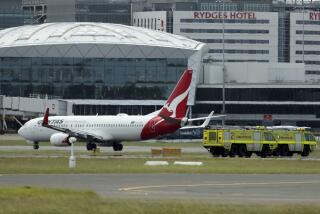No Smooth Sailing for Race Yachts
- Share via
The nine Whitbread Round the World Race sailboats are into their third leg, and it’s not getting any easier.
After a rough Southern Ocean experience, strong headwinds and one boat’s damaged mast have changed the 2,250 nautical miles along Australia’s southern coast from Fremantle to Sydney from an anticipated straightforward downwind drag race into a worrisome, hard-pounding tactical battle.
A high-pressure area of light wind to the south has forced the fleet to flirt with the rocky coastline of the Great Australian Bight, tacking into winds of 30 knots.
One exception was overall leader Innovation Kvaerner of Norway, which reported damage to its mast within 24 hours of restarting Saturday and went south to save strain on the rig.
Kvaerner skipper Knut Frostad reported by e-mail, “The outhaul hydraulic ram broke off the mast. A few hours [later crewman] Alby [Pratt] discovered that the bottom was buckled in on both sides.”
Frostad radioed to have repair equipment delivered by helicopter, which “almost landed on our stern” as the boat was anchored.
“We do now hope to be able to make the mast strong enough to finish the leg,” Frostad said.
Other boats reported less serious problems. Toshiba, the Dennis Conner entry with Britain’s Paul Standbridge as skipper, got tangled in a fish trap, lost a winch and flooded its bow compartment when a depth transducer pulled out of the hull. Sweden’s all-woman EF Education also lost a winch, leaving crew member Anna Drougge with a badly bruised hand. Ring attachments for their main sails tore away from the boom on EF Education and its sister ship, Paul Cayard’s EF Language.
Silk Cut skipper Lawrie Smith said his water maker, used to make sea water potable, broke down, forcing the crew to use a hand-operated device.
“We carry very little fresh water, with the water maker producing everything we need for cooking and drinking,” he said.
Smith said the fresh water produced by hand was about equivalent to the sweat generated in making it--1.5 liters in an hour.
“We are now searching for a model that takes sea water and turns it into beer,” Smith said.
Toshiba was the early leader, although the boats were closely bunched. They are expected to reach Sydney Dec. 22 or later.
More to Read
Sign up for The Wild
We’ll help you find the best places to hike, bike and run, as well as the perfect silent spots for meditation and yoga.
You may occasionally receive promotional content from the Los Angeles Times.




